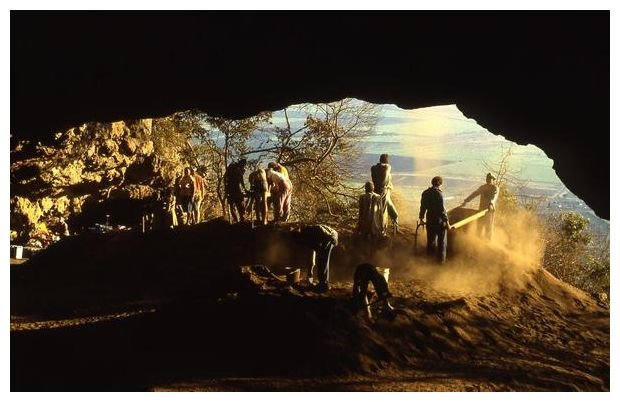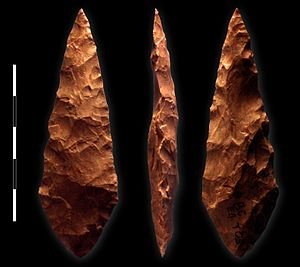The Middle Stone Age in Southern Africa :Dating and Palaeoenvironments
The Middle Stone Age in Southern Africa :Dating and Palaeoenvironments
Dating of MSA assemblages in South Africa

[1]
The greater part of South African Middle Stone Age (MSA) falls beyond the limits of conventional radiocarbon dating; in other words, this period is older than 50 000 years Before Present (BP).Other methods of dating such as AMS, thermoluminescence, oxygen isotopes stages and the superimposed layers of cave sequences are used to collerate the different phases of MSA. Today, pre 1960s dates younger than 20 thousand years BP are generally disregarded because of suspected sample contamination and because this dating technique has since been considerably refined and improved. Oxygen isotopes ratios resulting from a limited number of seashells are increasingly being used to date fossil remains. Geomorphic and faunal observations at the open sites of Florisbad and Duienefontein 2 suggest a late Middle Pleistocene age for these sites, but it is generally agreed that most MSA assemblages date to the Late Pleistocene. Although radiocarbon dating has been useful in attributing an age of greater than 40 thousand BP to many MSA assemblages, exact dating of the beginning of the MSA, the appearance of anatomically modern humans from MSA sites and the MSA/LSA transition is still unresolved or inexact. Two main reasons for this are the difficulty in obtaining dates for the material of pre-radiocarbon age and the fact that methods which could date this material are still being developed. No agreement has been reached about the position of the late MSA and the Early LSA since it seems that the sequence from late MSA to early LSA is not as clearly defined as once thought. By disregarding problematic dates for the MSA and early LSA a pattern emerges with no unquestionable early LSA dates older than probably 30 thousand BP and no reliable MSA dates younger than 20 thousand years BP. This suggests that the transition to an LSA technology occurred between 30 thousand years BP and 20 thousand years BP. Results of radiocarbon dating from Strathalan Cave B, Rose Cottage Cave, and from Lesotho and Swaziland, indicate that the MSA may have lasted longer in the more mountainous regions than in the coastal areas.
Some well-dated MSA assemblages were still present at about 20 thousand years BP, which is another reason for querying the early LSA dates from Border Cave. Certainly, the presence of microlithic artefacts, bone arrowheads, small-bored stones and ostrich eggshell beads suggest LSA affinities for these layers, but the presence of some flakes with faceted butts points MSA elements also. The problem lies with understanding the nature of the MSA/LSA technological transition, rather than with its dating.
Palaeoenvironments
The analyses of sediments and the faunal and floral remains from a number of South African cave sites with long MSA sequences (indicating that these cave sites were occupied for a long time during the MSA period) were expected to provide substantial palaeoenvironmental information. Palaeoenvironmental data are, however, difficult to interpret, since they respond erratically to environmental change. Palaeoenvironmental data can, however, be obtained through the following sources (Deacon & Lancaster):
~ Cave sediments accumulated by natural weathering.
~ Large mammal remains which were introduced to caves by humans and by other carnivores. We can make palaeoenvironmental inferences from the proportions of the different species, their size indices and our knowledge of their modern habits.
~ Microfauna. These are deposited mainly by owls in the form of pellets containing the undigested remains of prey (owls regurgitate pellets at their roosts in cave sites).
~ Pollen blown in by the wind.
~ Charcoal obtained from hearths (fireplaces) containing wood collected for firewood.
The following climatic conditions during the Late Pleistocene are indicated by palaeoenvironmental data obtained at some of the sites with long MSA assemblages:

[2]
~ Northern Cape: The sediment analyses from Kathu Pan, Wonderwerk Cave, the Ghaap Escarpment and Equus Cave indicate relatively dry Late Pleistocene environmental conditions,
with a cold spell occurring between 35 000 to 26 000 BP. Generally, conditions were cooler and moister than those of the preceding period.
~ Mpumalanga and Kwa-Zulu -Natal: The sites at Heuningneskrans, Bushman Rock Shelter, and Border Cave indicated rainfall between 30 000 to 10 000 BP.
~ Central Interior: Evidence from the Riverton formation on the Vaal River, Alexandersfontein, Rose Cottage Cave, and Florisbad shows cold conditions with alternating wet
and dry periods during the Late Pleistocene.
~ Western, southern and eastern Cape: data obtained from the MSA deposits at Boomplaas Cave, Cango Caves (speleothems), Klasies River Mouth, Nelson Bay Cave
Middle Stone Age tool from Blombos Cave [3]
Die Kelders, Elands Bay Cave and Diepkloof have provided a more detailed palaeoenvironmental record than elsewhere and this particular region is more sensitive to change than the South African interior.Long occupation sequences at these sites provide evidence of occupation for much of the Late Pleistocene. The Last Interglacial indicates conditions similar to those documented in historic times in the southern Cape. Evidence indicates cooling and the replacement of shrub-like vegetation and associated fauna with more grassland and associated grassland fauna in the period approximately 122 000 to 80 000 BP. Data from Bloomplaas Cave show cool, dry conditions between about 80 000 and 25 000 BP, but with very cold conditions at about 18 000 BP during the Last Glacial Maximum. Charcoal and microfauna point to wetter interludes during this period. Large mammals remains show little variation and, unlike microfauna, are not a sensitive marker for environmental change. According to Hilary Deacon, the Howiesons Poort stage of the MSA is simultaneous with a period of changing environmental conditions.
The correlation between browser-dominated fauna and warm interglacial conditions on the one hand and grazer-dominated fauna with cooler conditions on the other has been documented at a number of southern Cape sites. An increase in browsers and shrub vegetation at Border Cave in northern Kwa-Zulu Natal is interpreted as an indication of cooler temperatures, which suggests that conditions were not the same over the whole area.
In my following posts we will discuss The Subsistence and Behavior during the Middle Stone Ages in Southern Africa....
References :
~ [1] http://originalpeople.org
~ [2] http://www.scielo.org.za
~ [3] Wikipedia Image Source
~ Deacon & Lancaster
~ Hilary Deacon
Thank you for reading.
Thank you @foundation for this amazing SteemSTEM gif



Cool share @zest
Thank you @amaliatul
Congratulations @zest, this post is the most rewarded post (based on pending payouts) in the last 12 hours written by a User account holder (accounts that hold between 0.1 and 1.0 Mega Vests). The total number of posts by User account holders during this period was 1070 and the total pending payments to posts in this category was $1253.44. To see the full list of highest paid posts across all accounts categories, click here.
If you do not wish to receive these messages in future, please reply stop to this comment.
Very interesting information - upvoted
Hi @donkong, Thank you very much for the comment and support:)
You are welcome :)
Very informative @zest. Thanks for the knowledge! (Indy is also one of favorite movie characters) :D
Hey!!! Hi @lordkingpotato. Thank you so much for the great comment. You got to love Indiana Jones, they could have done a better job with the latest one , "The Kingdom of the Crystal Skulls" but it was great to have him back after so many years:) I really apprecaite your support!!
Great work @zest, it appears you have an in depth knowledge of archaeology and the ways of rediscovering ancient history.
I am wondering if you can help me. ? I am following some trails about paleoparasitology and seeing how those same parasites are affecting humanity today. Would you know where I can find references to parasites about 10,000 years ago, especially around the mediterranean ..?
Thank you so much @quantummonks for a really confidence boosting comment, your topic is really intriguing, I would really like to assist you, it would also be a learning experience for myself. If you can please DM me on Steemit chat, I will check with my collegues on how to obtain that information.
Hi Zest, sure your interest would be welcome. New to chat, so I will check it out..
dig up historical sites and introduce them to the world. Amazing work buddy :)
Hi @kharrazi, Thank you for that great comment:)
Nice post ☺👍
Thank you @thashil